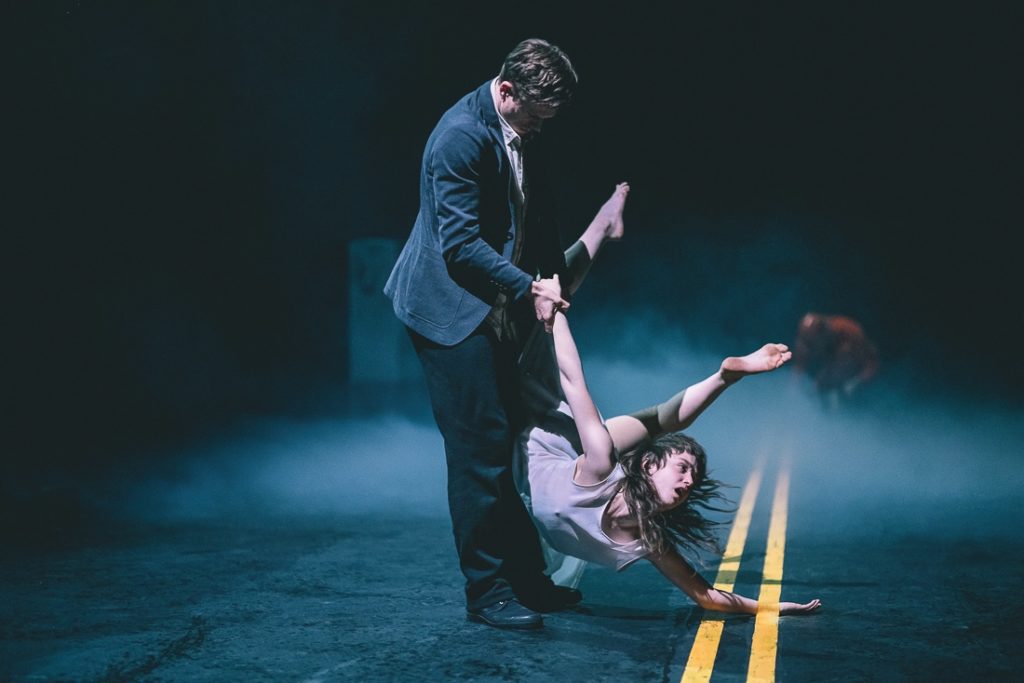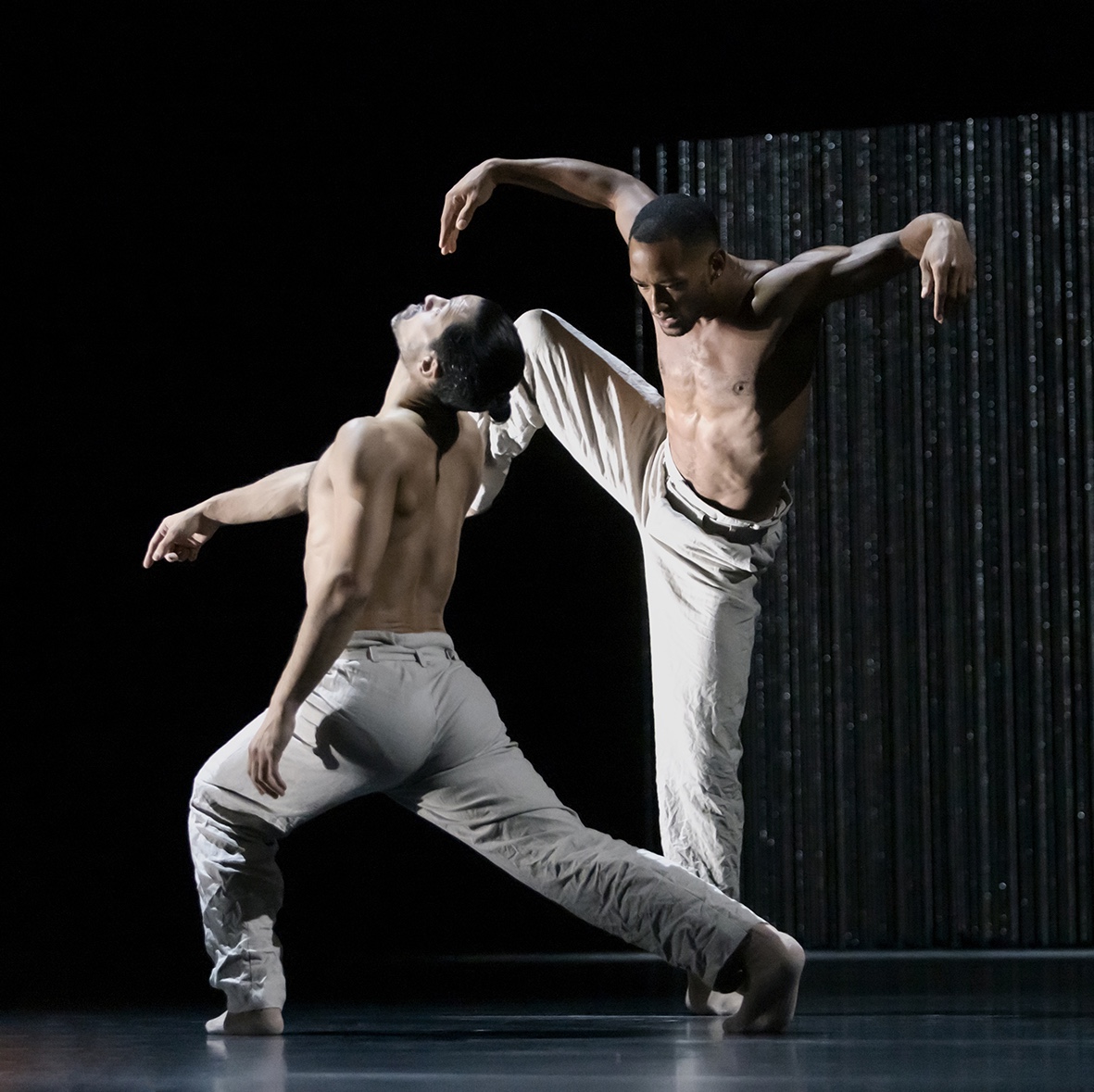Words by Bengi-Sue Sirin.
Wednesday 19th April was a very exciting night for me. I have put Nederlands Dans Theater on a pedestal ever since I discovered them on YouTube as a dance-mad teenager. Gods and Dogs was one of my most viewed videos. Their dancers are capable of almost anything, their choreography is in equal parts fresh, stunning and shocking, and their tone has a particular edge to it. So the opportunity to see them perform, finally, was thrilling. It wasn’t just an exciting night for me – opening night at Sadler’s Wells was packed, bustling with dance fans and critics and even well-known dancers (another dream of mine came true bumping into Marcelino Sambe from the Royal Ballet on his night off!) The sense of ‘Event’ was rife.
The evening presented three pieces by three respective choreographers. First, La Ruta by Argentinian dance-maker Gabriela Carrizo, suggestively subtitled in the program as ‘bleeding through the cracks of a dream…’ The curtain lifted to reveal a desolate bus stop at night time and some bags of garbage, visible in dregs through the haze of smoke. Throughout La Ruta, various peculiar characters approach the bus stop on night-time journeys somewhere unknown. The twist: most of them have their journey cut short by the thwacking Doppler effect of a speeding vehicle. It is more than just a piece about hit and runs, though. La Ruta is characterised by the Doppler effect, in tempo and in shock factor. As each person or group enters the stage, the pacing is slow and cavernous, giving us time to take in the visual clues about their possible identity, to mull over the sinister tone of a bus stop in the middle of the night. Then comes the crash; that immediate cone-shaped increase in volume and lighting, signifying a vehicle hurtling in a fatal direction.

Impact and intensity are instantaneous – but rather than causing death and stillness, the crash induces unrestrained, desperate movement. One dancer, when hit, drops to the floor in a tight helix. Suddenly she releases like a literal sprung coil, into backwards corkscrew spirals so forceful that I scribble ‘seizure-like.’ She is like a fish out of water, raw and anguished but at the same time magnetic – it puts me in mind of the portraits of Egon Schiele, full of rage and defiant beauty. The music at this point sounds like a saw violin, subverting the aesthetic of beauty in a parallel way to the dancing. La Ruta reminds me of something very specific. The realm of cultural theorist Mark Fisher, night bus journeys home to South London suburbs at 4am, with sounds of ‘broken glass crack[ing] underfoot.’ Indeed, like Fisher’s description, the NDT dancers seem ‘like wounded or mutilated angels: angels whose wings have been clipped, or who have been trapped or betrayed.’ It is a post-apocalyptic, Ballardian world with builders, seagulls and Nick Cave lookalikes that some have described as more physical theatre than dance, but that for me, is dance in extremis, to quote Fisher, ‘dance after the rave.’ La Ruta ties together all these in extremis elements; JG Ballard’s Crash, Mark Fisher, Schiele… I can’t think that I’ve seen a dance piece coming from this specific dark place before, and I like it.
I was very grateful for the interval to process La Ruta, and also to gear up for seeing Gods and Dogs. The popular piece was first choreographed in 2008 by NDT’s chief helmsman, the now retired Jiri Kylian. It was Kylian’s 100th piece for the company, in his words exploring ‘the twilight zones… the border between normality and insanity.’ I certainly got a sense of the dualities that he describes. One channel was the sparse yet sumptuous set, at times a glossy black backdrop with cleverly placed lighting, at other points huge chocolate-box gold beaded curtains from ceiling to floor. The set became a way to personify the blurring of borders, as dancers disappeared beneath the backdrop a la The Truman Show. A giant black dog loomed towards us in slow motion, at once a god and a dog. Those three elements were simplistic but also deeply visceral; a mysterious holy trinity.
There are fantastic dance motifs throughout the whole piece, but Gods and Dogs sings during its duets. One I especially enjoyed featured one of those almost serendipitous working together of two bodies, whereby a female dancer sprint-crawled backwards seemingly nowhere, and a male dancer manoeuvred forward seemingly nowhere, and they slotted into one another perfectly, unforeseen. As I watch I think of Wayne McGregor’s Chroma, which although it was choreographed earlier in 2006, definitely takes inspiration from Kylian’s style, ubiquitous and influential in contemporary dance as it is.
Gods and Dogs is not static, it builds. The last section is heady, both musically and choreographically. Hearty strings convey the idea that time is running out, creeping away from us ominously. A duet so frenetic that the dancers seem to transcend their bodies entirely, becoming androgynous shapes that cannot be pinned down. One dancer creates hoops with his limbs for his partner to sprout through, like particles connecting in space. She charges headfirst into him; he kicks her back; where there should be pain from impact there is not, because they are so marvellously in sync. Something remarkable about Gods and Dogs is its timelessness. It defies temporal placement, and could be just as convincingly about the long gone past as it could the far off future. No wonder it ages so well. I love it.

The third and final piece of the evening is Figures in Extinction [1.0], a collaboration between much-loved Canadian choreographer Crystal Pite and English theatre director Simon McBurney. For the two creatives the climate crisis is a shared inspiration. In fact, it was McBurney’s six year old daughter who posed the question that posed the piece; seeing that a once-regular bird visitor of their garden had ceased coming, she asked, “Where has she gone, has she gone forever?” The normalisation of extinction to an extent that six year olds comprehend it is devastating. As the curtain lifts I wonder, will this be the bleakest of all?
Avoiding a narrative structure is one way Pite ensures Figures in Extinction [1.0] does not feel as if it spirals into hopelessness. Instead, the premise is a series of vignettes, each focusing on a particular extinct/endangered species or landform and bringing it to life through the agile forms of NDT. Sometimes these dancers’ bodies are lent a little help by the occasional props of fossil remains, such as the giant tusk-horns of the Pyrenean Ibex in vignette number one. The dancer places them, tentacle-like, onto his arms, creating a silhouette that makes me think simultaneously of insects, reptiles and things that lurk deep below the sea’s surface. He twists in whorls with the quiet calm of a martial arts sensei, and I can just feel that everybody is captivated by such power and grace. The Pyrenean Ibex sadly became extinct in the year 2000, but Pite and McBurney demonstrate that it never lost its magnificence.
It is really difficult to choose just a few vignettes to write about because they were all breathtaking, but I feel I must mention the tribute to the South Selkirk Caribou Herd. Here, strength lay in numbers; the whole NDT cast assembled in herd formation against a Neolithic-esque backdrop, lit by a black and orange dusk sky, was something I will never forget. They truly embodied the caribou, with their undulating, downwards shoulders and heavy centre of gravity. A rapid fire canon effect of them rising to look backwards over their shoulder in that specifically animalistic stance was shockingly realistic.
I must also pay homage to the Spider Orchid section, where a central woman dancer was symmetrically ensconced by four outer dancers, one by each of her limbs. There may have been five dancers but they moved as just one spider-being. The central dancer would jut or jerk in a direction and taking her lead, the others would briskly scurry out in her wake. Working together with gossamer-thin timing, the overall effect was identical to a spiderous movement. Something special about this piece is the way it dances on the imagination, bringing the natural world to life so cannily on human bodies. We are all flies in the web of Crystal Pite’s choreography!
As you can probably tell, Figures in Extinction [1.0] continued smartly on from the prior two pieces the theme of dance-after-the-abyss, the gloriously post-apocalyptic feel of the night. But despite its heavy subject matter, the piece had a touch of lightness and joy that the other two didn’t, which I think was down to the sparkle of wit on show in the large group ensembles. As I described, animals were summoned up out of nowhere before our eyes, given another chance to live on the stage at Sadler’s Wells.
That said, I find it impossible to compare the three dances. For me, it was a night of the kind of dance that opens your mind up and lets everything in, the darkness and the light. The NDT company dancers transported us somewhere very special – not Holland, but a realm of metaphor and movement. Dance in extremis, to the farthest reaches of the body’s potential and the mind’s imagination.
